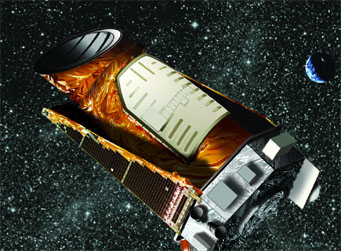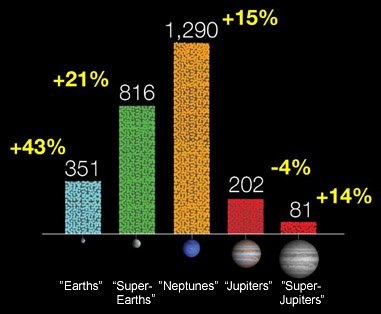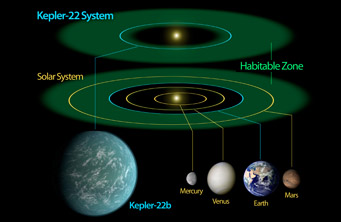NASA's Kepler telescope has discovered 461 new planet candidates, four of them Earth-size candidates in "Goldilocks orbits" — meaning temperatures on these planets would permit liquid water.

An artist's impression of the Kepler spacecraft, which is basically a wide-field photometer fed by a 37-inch (0.95-m) telescope.
NASA / Ames Research Center
Two years ago, mission scientists for NASA's Kepler space observatory announced the discovery of a mind-boggling 1,235 new planet candidates, each revealed by the tiny dip in brightness created as it passed in front of its host star. The next year, they announced another 1,086 candidates. This week, attendees at a meeting of the American Astronomical Society heard a new number: 461.
It might sound like a letdown, but numbers can be deceiving. Kepler's hitting a new stride these days, coming teasingly close to its ultimate goal of detecting Earth-like planets orbiting in the "habitable zones" of Sun-like stars, where water could survive on a rocky surface.

The distribution of candidate planets discovered in Kepler data, as of January 7, 2013. Since its previous release in February 2012, the Kepler census has increased by 20% and now totals 2,740 potential planets orbiting 2,036 stars. Click here for a larger version and a more complete explanation.
NASA
Most of the newest planet candidates are less than twice the size of Earth. Four of these are in "Goldilocks orbits," neither scorchingly close to their host star nor beyond the ice line. And one — evocatively named KOI ("Kepler Object of Interest") 172.02 — orbits in the habitable zone around a Sun-like star every 242 days. This first candidate to satisfy Kepler's goal is 1.5 times Earth's size, with a balmy temperature of 46°F (8°C) — or at least that's the estimate made under certain ideal conditions, such as having the same temperature on its day and night sides.)
Meanwhile, Kepler is finding fewer of the largest exoplanets, actually seeing negative gains among the Jupiter and super-Jupiter class, because the vetting system is getting better at weeding out false signals.
Kepler's newest data release also shows an increase in the complexity of these alien arrangements: the spacecraft added 102 new multiples to its previous list of 365, including a trio of five-planet systems.
"That makes me smile," says Natalie Batalha (NASA Ames Research Center). "It was just a couple years ago when we didn’t have any multiple system and now we have hundreds."
The total tally of Kepler-detected exoplanet candidates now stands at 2,740 planets around 2,036 stars. (Access an interactive table with Kepler's exoplanet candidate list here.) Follow-up observations with ground-based telescopes haven't kept pace with the spacecraft's rapid-fire discovery rate, but so far 105 candidates stand confirmed as bona fide planets.
Kepler's 461 new candidates come from a much longer list of 13,000 "threshold-crossing events". These TCEs represent the first step in the discovery pipeline, and the vast majority of these won't turn out to be planets, says Christopher Burke (SETI Institute). Nevertheless, Kepler recently released a list of TCEs to the community, in the hope that researchers not on the Kepler team might come up with their own methods of pruning the list. Francois Fressin (Harvard-Smithsonian Center for Astrophysics) cautions, "We encourage the community to use these TCEs, but we don't encourage them to make crazy claims!"

Kepler-22 b, a planet known to comfortably circle in the habitable zone of a Sun-like star, is more than twice the size of Earth and orbits a Sun-like star at a distance very comparable to our planet's.
NASA / Ames / JPL
Another team looking through Kepler data is Zooniverse's Planet Hunters. This project enlists the aid of citizen volunteers to sort through Kepler's light curves, looking for the characteristic dip that indicates a planet. If enough people observe the same light curve, the team can eliminate false positives — a signal that looks like it's due to a planet, but isn't. So far, the group has found one confirmed planet and 31 planet candidates, 15 of which occupy their star's habitable zone. Even though all of these planets are gas giants, life as we know it could still exist on large moons orbiting one or more of them.
Pruning is an issue for Kepler's planet-candidate list, too; some false positives still slip though. The expectation, Burke says, is a false positive rate between 10% and 20%. But the actual count of impostors depends on the size and orbit of the purported planet — giant planets in close-in, short-period orbits are less likely to be real than small planets in long-period orbits, for example — so getting the pruning right is important for our understanding of the growing exoplanet population.
Fressin and others recently simulated a Kepler-like survey to account for the real survey's shortcomings, such as the planet-search algorithm's inability to distinguish between a planet and a eclipsing binary star in the background. Even with such occasional lapses, Fressin found in his simulation that 90% of Kepler's candidates are genuine planets.

William Borucki, Kepler's lead scientist, has championed the idea of detecting planets around other stars by precisely recording their transits since the 1980s.
NASA / Kepler
Once Kepler's impurity was accounted for, Fressin and his team estimated how often planets occur. What they found, using the more limited set of 2,012 candidates, is that one in six stars has an Earth-like planet inside an orbital distance comparable to Mercury's. These exoplanets are far too hot to be habitable, but Fressin will be able to apply the same method going to future data sets to refine Kepler's "magic number" — the count of stars with Earth-like planets in their habitable zones.
In related news, William Borucki, Kepler's project scientist, has just been awarded the prestigious Henry Draper Medal by the National Academy of Sciences. As detailed in this NASA press release, Borucki was recognized "for his founding concept and visionary leadership during the development of Kepler." The award is well deserved: Borucki first proposed the mission in 1984 and lobbied 25 years before it became a reality.
 6
6









Comments
Dave Weixelman
January 8, 2013 at 8:35 am
Fascinating article on the Kepler mission. Are the locations availalble for particular KOI objects?
You must be logged in to post a comment.
Monica Young
January 8, 2013 at 8:53 am
Yes, the locations of all 2,740 KOI objects are available via an interactive table, accessible from this link: http://exoplanetarchive.ipac.caltech.edu/. (I've added this link to the story too.)
You must be logged in to post a comment.
Anthony Barreiro
January 11, 2013 at 5:49 pm
Thank you for this clear summary and explanation of these most recent announcements and plans for next steps. With all the hoopla and extravagant suppositions surrounding exoplanet discoveries, it's good to know what we actually know, in terms a layperson can understand.
You must be logged in to post a comment.
BarryB
January 11, 2013 at 6:36 pm
It would appear that the number of planet-like objects that can cause a star to dim would be on the same plane of the star and us. That would appear to preclude a huge potential # of planet-like bodies around stars that may not be on the same plane with us ????
You must be logged in to post a comment.
Rod
January 12, 2013 at 11:35 am
Thanks for including the NASA archive link. It is very useful, folks who want to can download various files in different formats like .csv. I did and ran some quick stats of the 2740. Average semi-major axis = 0.17 AU, average planet temperature = 834 K. Average planet radius = 3.58 earths. Most of these Kepler finds are orbiting very close to their host stars. The max semi-major axis = 63.9 AU and max size = 89 earth radii. The hottest in the list = 4859 K. I think I will stay here on earth and not boldly go to some of these hot spots 🙂
You must be logged in to post a comment.
Bruce
January 13, 2013 at 5:10 am
You’re RIGHT BarryB! By your 4 question marks perhaps this was a new thought to you? If so don’t feel bad, I’m sure many must think that the great majority of the universe’s planets must be broiling star huggers, like the Kepler stats that Rod has listed. But the facts are that several of the best methods for finding exoplanets (transits, radial velocity) are excellent at finding close in worlds but are rather poor at finding worlds in the so called Goldilocks zones. The only reason Kepler has any hope of finding planets that far out from the stars they orbit is because it is starring at > 156,000 cases in the expectation that at least a few stars in this massive set have planets with orbits so perfectly aligned with us that we can observe the transits.
You must be logged in to post a comment.
You must be logged in to post a comment.